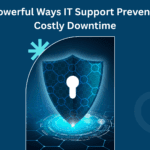
Data breaches are an unfortunate reality for businesses of all sizes. When a breach occurs, the immediate response is critical. How a company manages the aftermath can significantly impact its reputation as well as financial stability and legal standing.
The average cost of a data breach has reached 4.88 million USD.
Effective damage control requires a well-planned approach. However, common pitfalls can exacerbate the situation. This article will guide you through the key steps of data breach damage control and highlight the pitfalls you should avoid to reduce the impact.
Pitfall #1: Delayed Response
Following a data breach, one of the most critical errors a company can commit is to postpone its response. The longer the delay, the greater the potential for additional data loss and a decline in customer trust.
Act Quickly
The initial step in damage control is to act swiftly. Once you detect a breach, initiate your incident response plan. This plan should involve containing the breach, assessing the extent of the damage, and notifying affected parties. The quicker you act, the greater your chances of minimizing the damage.
Notify Stakeholders Promptly
Informing stakeholders, including customers, employees, and partners, is crucial. Delays in notification can lead to confusion and panic. This makes the situation worse. Be transparent about three key things:
- What happened
- What data was compromised
- What steps are being taken to address the issue
This helps maintain trust and allows affected parties to take necessary precautions.
Engage Legal and Regulatory Authorities
In case of a breach, it’s important to be aware of the specific nature of the breach and determine whether it’s necessary to notify regulatory authorities. Failing to do so in a timely manner can lead to legal consequences. It’s crucial to have a clear understanding of the legal obligations regarding breach notification and to adhere to them promptly.
Pitfall #2: Inadequate Communication

During a data breach, effective communication is crucial. Inadequate or unclear communication can result in misunderstandings, frustration, and further damage to your company’s reputation. How you communicate with stakeholders is of utmost importance as it sets the tone for how your company is perceived during the crisis.
Establish Clear Communication Channels
Establish clear communication channels to keep stakeholders informed. This could include:
- A dedicated hotline
- Email updates
- A section on your website with regular updates
Ensure that communication is consistent, transparent, and accurate.
Avoid Jargon and Technical Language
When communicating with non-technical stakeholders, it’s important to avoid using technical jargon. The goal is to ensure that the information is accessible and understandable to everyone. Clearly explain what happened, the steps being taken, and what the stakeholders need to do.
Provide Regular Updates
It’s important to keep stakeholders informed by providing regular updates as the situation develops, even if there is no new information. This helps reassure stakeholders that the situation is being actively managed.
Pitfall #3: Failing to Contain the Breach
Another critical mistake is failing to contain the breach quickly. Once your business detects a breach, take immediate action. This will help prevent further data loss. Failure to do so can result in more significant damage.
Isolate the Affected Systems
The first step in containing a breach is to isolate the affected systems. This may involve:
- Disconnecting systems from the network
- Disabling user accounts
- Shutting down specific services
The goal is to prevent the breach from spreading further.
Assess the Scope of the Breach
Once you contain the breach, assess the scope of the damage. Identify what data was accessed as well as how someone accessed it and the extent of the exposure. This information is crucial for informing stakeholders and determining the next steps.
Deploy Remediation Measures
On After assessing the scope of the breach, deploy remediation measures. They should address the exploited vulnerabilities. Ensure that your company takes all necessary steps to prevent a recurrence.
Pitfall #4: Neglecting Legal and Regulatory Requirements
It’s important to remember that disregarding legal and regulatory requirements can lead to serious consequences. Numerous jurisdictions have stringent data protection laws that outline how businesses should handle data breaches. Failing to adhere to these laws can lead to substantial fines and legal repercussions.
Understand Your Legal Obligations
Familiarize yourself with the legal and regulatory requirements in your jurisdiction. This includes understanding the timelines for breach notification as well as the specific information your company must provide and who you must notify.
Document Your Response
Documenting your response to a data breach is crucial for demonstrating compliance. This documentation should include:
- Timeline of events
- Steps taken to contain the breach
- Communication with stakeholders
Proper documentation can protect your company in the event of legal scrutiny.
Pitfall #5: Overlooking the Human Element
The human element is frequently disregarded in the process of responding to data breaches. However, it is important to recognize that human error can play a significant role in contributing to a breach. Furthermore, it’s crucial to consider the emotional impact that data breaches can have on both employees and customers, as it can be quite substantial. Therefore, addressing the human element is essential in order to ensure a comprehensive and effective response to data breaches
Support Affected Employees
Provide employees with support if the breach compromised their data. This could include:
- Offering credit monitoring services
- Providing clear communication
- Addressing any concerns they may have
Supporting your employees helps maintain morale and trust within the organization.
Address Customer Concerns
In the event of a data breach, it is important to acknowledge and address customers’ concerns promptly and empathetically. Providing clear instructions on steps they can take to protect themselves, and offering assistance where possible, can help to maintain customer loyalty during such challenging times.
Learn from the Incident
Finally, use the breach as a learning opportunity. Conduct a thorough post-incident review. Identify what went wrong and how it can be prevented in the future. Deploy training and awareness programs to educate employees on data security best practices.
Manage Data Breaches with Help from a Trusted IT Professional
Data breaches are challenging. How your company responds can make a significant difference. Do you need IT support that has your back? We can help you both prevent and manage breaches to reduce the damage.
Contact us to schedule a chat about cybersecurity and business continuity.






